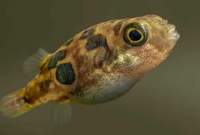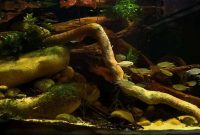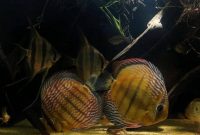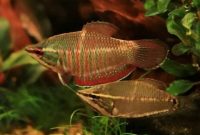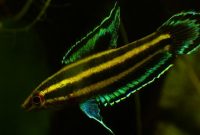Freshwater Amazon Pufferfish Caresheet – Many saltwater fish families have evolved to live in freshwater and brackish water environments worldwide. One of them is the pufferfish species (family Tetraodontidae). But, only a few aquarium hobbyists have an interest in these species as their pets.
Several truly tropical puffer fish inhabit some freshwater streams located in Asia and Africa. But, there is one of “oddballs” freshwater pufferfish only found in South America.
Are you feel curious about this one?
In this article, we will share all information about these pufferfish species starting from A-Z. If you are looking for quick information about them, you can see the table of contents below. Keep reading if you want to learn more deeply about these pufferfish.
TABLE OF CONTENTS
Amazon Puffer Care Overview
- Care level: Intermediate
- Minimum tank size: 40-gallon
- Temperament: Peaceful and sometimes become fin nippers
- Lifespan: 10 Years
- Diet: Carnivore
- Temperature: 72.0 – 82.0° F
- pH: 6.0 – 7.5
- Size: 8 cm (3.1 inches)
- Family: Tetraodontidae
- Genus: Colomesus
Species Overview And Origin
The freshwater South American pufferfish (Colomesus asellus) is usually called Amazon puffer, Peruvian puffer, SAP, Bee puffer, Bumble Bee pufferfish, Brazilian puffer, Asell’s puffer, and asellus puffer. C. asellus first described in 1849 by Müller and Troschel. They are unusual freshwater pufferfish native to Amazon, Orinoco, and Essequibo basins in tropical South America.
According to a study in 2013, a population has a slightly similar appearance with C. asellus in the Tocantins River basin but differs in genetics. These species are known as Colomesus tocantinensis; now, there are two freshwater pufferfish species that originate from South American.
The locals commonly called the amazon pufferfish “pez globo.” They typically live in open water habitats, mostly found around sandy shallows. These pufferfish are also discovered in other areas, including beaches, banks with plenty of vegetation, and floodplain lakes.

Amazon puffer prefers fast-moving water where richest with oxygen dissolved and contain many crustaceans and mollusk as their favorite foods. These puffers believed might be sensitive with low-level oxygen availability. The water hardness which can they accepted includes soft, slightly acid, or hard.
Some aquarists believe that these puffers can tolerate brackish water. Some populations adapt well in the upper Amazon’s tributaries; however, they tend not to be found in blackwater environments where the environments are highly acidic.
South American pufferfish is perfect for an expert aquarist trying to keep an exotic fish who wants to create a new atmosphere in their tank. These species are rare to find in the trades, so the price is relatively high. A single healthy adult amazon pufferfish is usually selling for $30 or more.
Read Also: “Carinotetraodon Travancoricus” The Smallest Freshwater Puffer Fish
Amazon Puffer Fish Appearances
Colomesus asellus typically grow up to 8 cm (3.1 inches) in the wild, but in the aquarium might be quite a bit smaller. They have a yellow-green tint at the upper parts of their bodies, and the bellies are white, but they have different patterns.
Amazon puffers also have five dark stripes that run across of upper part body: 1 above the eye, 1 behind the eye, 1 under the dorsal fin, 1 behind the pectoral fin, 1 ring right before the tail fin. These stripes may vary in pattern between individuals.
On the internet, you may find another pufferfish closely similar to C. asellus, Colomesus Psittacus (banded puffer) is brackish puffers species that grow larger than them (grow up to 14 cm). The most prominent distinguishing between both sexes is C. asellus has black spots on the underside of the caudal peduncle, while the other one is not.
The banded puffer also has extra back stripes and smaller eyes. These brackish puffer species are also unpopular, so you might not find them at the average aquarium shop.
An interesting fact about amazon puffers fish is that they are species that can blink and close their eyes. They do not have pure teeth; instead, a jawbone acts like four teeth structures that grow continuously and quickly. So, the food with hard-shelled such as snails or shellfish could help to ‘trim’ their jawbone down. Because if it develops overgrown, these puffers would not consume their food and may die.
Read Also: Clea Helena The Assassin Of Aquarium Pest Snails
Sexual Dimorphism
Like most other puffer species, differentiating between both sexes is difficult.
Amazon Puffer Fish Behavior And Temperaments
Keeping amazon pufferfish is fun; they are intelligent and very curious species. If there is an unusual thing in their tank, they will investigate it quickly and observe it inch by inch with their big eyes.
When the keeper gets associated with them, they will beg for food if they are hungry without feeling shy. These freshwater fish are relatively active; you will see them swimming the length of their tank.
But, if the amazon puffer gets stressed, they will be an erratic swim; this behavior is called “glass surfing.” Sometimes, they are starring at the glass, which means these fish are bored. So, you can add a new decoration into their tank to raise their curious behavior.
Unlike most tetraodon families, these puffers are not aggressive and non-territorial toward tankmates and live well in the mixed-species aquariums. In fact, they are more suitable for keeping in small groups, ideally about three members or more.
If you keep only a single fish of amazon puffer in the aquarium, they commonly tend to be nervous. However, putting them in large groups is not the right way if the space is not sufficient. It precisely makes these fish easily restless and scared.
Sometimes, the larger one might bully the smaller fish, but it is rarely and usually occur in a short time. To resolve the bullying problem between each other, adding some specimens will make any fish difficult to become more dominant in groups.
Although they perform well in groups, the amazon puffers swim together with other members only for a short period before every individual decides to do their own thing for a while. When the night comes, all members will come together to sleep in the same place of the tank.
In their habitat, they generally spend much time swimming in open water or exploring the surfaces of aquatic plants and stones, while entering the caves is rarely performed. When sleep-time comes, they tend to choose a patch of fine gravel or sand planted of robust plants such as Amazon sword as a resting place. Different from Asian species, the South American pufferfish are infrequently digging into the substrate.
Read Also: 5 Effective Ways To Get Rid Of Ramshorn Snails In The Aquarium
Amazon Puffer Fish Lifespan
However, the Amazon pufferfish bodies are smaller than other fugu species, but their lifespan is longer and may reach up to 10 years. The mix of genetics and quality can affect their average lifespan.
If you do not give the Amazon puffer the optimal quality care they need, achieving ten years of age is impossible. So, if you follow the step by step to keep them in this article, your fish may grow more healthy and live longer.
Read Also: 45 Nano Planted Tank Setup Design Inspirations To Displayed At The Office
Amazon Puffer Housing & Tank Setup
According to the statement above, the South American puffer will live well if kept in small groups or communities. For keeping them in the aquarium, you need 40 gallons tank size to accommodate 3-4 fish. You are providing them more space in the tank, helping them thrive better and easy to maintain because they are active swimmers and messy eaters.
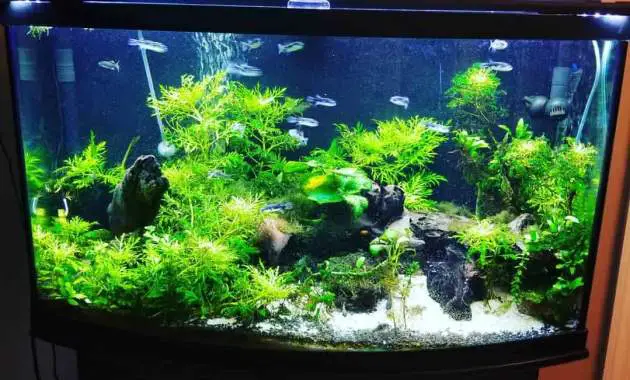
Using sandy substrate or fine gravel is preferred; it resembles a natural substrate in their wild habitat. Use high rich nutrient substrate to increase the growth of aquarium plants; these puffers are very appreciative of the lush plants in their tank. The fine substrate (such as Fluval black sand) can also grip the roots firmly to make your plants stand sturdy.
Planting some aquatic plants helps enhance Oxygen dissolved in the aquarium; it’s very critical if it is not in. It would be best to grow aquatic plants with thick and heavy leaves such as anubias species, cryptocoryne, Cabomba, etc.
Adding extra floating plants serves shading areas in the aquarium suitable for the amazon puffers when feeling nervous. They also might become an interesting object for the fish observed.
You can put a few decorations such as rocks or woods into the tank. Do not over-placing hardscapes; these puffers are more prefer open water to do their activities.
A high-quality filtration system is essential; you can set it medium-high for water flow. Amazon puffers often leave leftover food or feces at the bottom of the aquarium, so you will need the filter that can siphon it overall.
There is no specific requirement for the lighting system, but you can set it at the low-medium level. Using a heater is optional; every place has a different temperature, as well as water. So you can fit it with the conditions where the aquarium is placed.
If you need a specific water parameter that is suitable for Amazon puffers to live, here’s below:
- pH level: 6.0 – 7.5
- Water Temperature: 22.2 – 27.8° C (72.0 – 82.0° F)
- NO3: < 15 ppm
- Water Hardness: 5 – 20 dGH
- Brackish Tolerance: Sometimes – Up to SG 1.005
Read Also: South American Fish For Aquarium That Native To Blackwater
Amazon Puffer Fish Care
As we know, the Amazon puffer can survive in a wide range of water in the wild. But, one thing that becomes a crucial point to care for them is water quality. It means the water needs to be recycled frequently to ensure it is far away from nitrate and ammonia.
The South American puffers do not have gill covers or scales makes them more susceptible to diseases. Then, they have lousy behavior. They often leave a few parts of their food in the aquarium (messy eaters), which affects the water quality and give more load to the aquarium filtration.
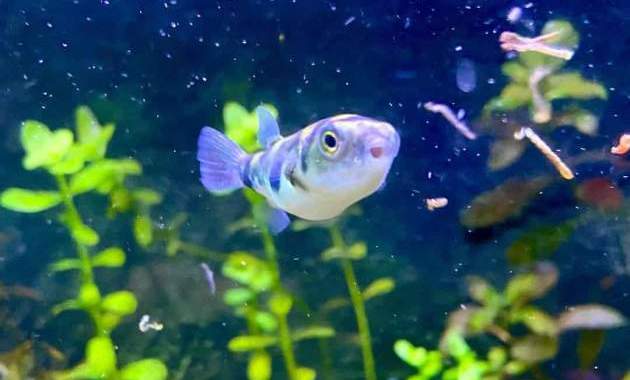
To handle that problem, you can perform water change about 30% – 50% weekly; it’s a standard rate for a puffer tank. You will require a larger canister filter to recycle the water 6-10 times per hour. It would be best to test the water regularly with a liquid test kit, although you think the water quality is acceptable.
The bumblebee puffers are particularly sensitive when entry to a new tank; make sure to present an optimal condition these fish need in your tank.
Read Also: Are Axolotls Good Pets For You? It’s A Complete Guide Of Keeping, Feeding, Behavior, Characteristics
Amazon Puffer Fish Tankmates
Unlike most puffer species, The South American puffers are suitable for communities aquarium settings. They are peaceful and tolerant of the non-aggressive species. However, sometimes they still can be annoying to the long fins, passive and slower-moving species, though commonly just at feeding time. So, these fish are not recommended to keep together with long-fins tetra, angelfish, and gourami.
The larger, territorial and aggressive such as larger gourami species is must be avoided; the puffers may get bullied by them. Small, faster bottom dwellers like corydoras are better options for their tankmates; although they move quickly, they might still get fins nipping by the amazon puffers.
You can also keep them with short-finned and fast-moving species, including larger rasboras, rams, medium-sized characins, Apistogramma, hatchet fish, and glassfish. On the other hand, crustaceans and mollusks are never be used as their tankmates because they might be hunted by the amazon puffers as their snacks.
Read Also: 10 Good Reason Why You Should Have An Aquarium Fish At Your Home
Amazon Puffer Fish Diet And Feeding
Colomesus asellus is carnivorous; in the natural habitat hunt extensively smaller creatures such as crustaceans, larvae, and snails. In the aquarium, you can feed them with snails, cockles, or crab legs to maintain their jawbone (teeth-like) to hold it grow over.
Other food that is accepted by them includes chopped shellfish, Artemia, bloodworm, earthworms, frozen shrimp meats, and other live or frozen fish food. Conventional dried products such as pellets and flakes may be accepted or not, depending on the fish individual.
Read Also: COMPLETE Blackwater Fish Tank Setup Guide
Amazon Puffer Fish Breeding
Unfortunately, it is not possible to breed the C. asellus in home aquaria or captivity. The Amazon puffers’ fish breed behavior is identical with most marine puffers, they produce tiny eggs with large numbers, and the fry should be passed through a planktonic phase. The fatal thing is that these freshwater pufferfish do not build a nest and do not take part in caring for the babies, making them difficult to breed manually.
When the wet season begins in their wild habitat, the female and male puffers come together in large river streams to release their eggs and sperms into the water. According to limited studies, the spawning session usually occurs in primary river channels, tributaries, and banks at the mouth of floodplain lakes.
Once the fertilized eggs are hatch, the fry that appears might be drifted by the water flow into a specific nursery zone and then developed there. In this period, the fry may consume planktonic organisms around them to survive.
The metamorphosis process may take a couple of days; when they can swim strong enough, the young amazon pufferfish will try to swim against the current actively. While the parents will go back to river channels when breeding season is over (usually when floodwaters recede).
Read Also: How To Stop Green Dust Algae Grow In The Aquarium
Common Diseases That Possible Infected Amazon Pufferfish
White spots and fin rot is common diseases that usually attack South American pufferfish. Actually, they are hardy fish, but they might be prone to sickness if you keep them in poor conditions. So please give them the best tank environment that they need.
Generally, the Amazon pufferfish will give well respond to medications and recover immediately. API Super ICK CURE is the best solution to fight whitespots, and API FIN & BODY CURE is believed effectively to treat the fungus and finrot.
Adding aquarium salt three doses per liter and raising the water temperature around 28 – 30 degrees Celcius might be an alternative way to kill parasites without harming the fish for the long term. Once your fish is really free from disease, do a water change and reduce the temperature to the standard (around 25 degrees Celcius).
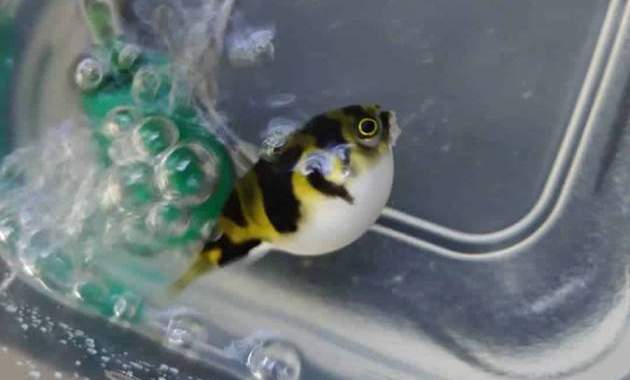
Another health problem from the Amazon pufferfish is their teeth growth. The first method to hold their teeth overgrow was shared above; now, the second method is manual. This process is simple, take 1-liter aquarium water into a box, add two or three drops of clove oils and stir it.
Next, catch your pufferfish using a net and put them into an oil bath until the fish calms down. After that, grip the puffer softly using your hand and trim their points of jawbone-like teeth using cuticle clippers in your other hand.
Then, drop the puffer into the net again and carry it back to the aquarium. Hold them still in the net until the fish become active again. This process may take a few minutes. After that, you can release your fish back to swimming happily in the tank. Most aquarist usually trims their Amazon pufferfish teeth one or more times per year.
Read Also: Licorice Gourami: The Unusual Blackwater Fish
Are The Amazon Pufferfish Poisonous?
Yes, Colomesus asellus is poisonous if you consume them as food. Their toxin (saxitoxin) is accumulated in their flesh. This poison is generated from scientific bacteria and certain algae that grow on a certain shellfish.
The venom in the Amazon pufferfish fluctuates throughout the years depending on how many components produce the toxin they eat. Without access to the poisonous diet, the wild-caught South American pufferfish will lose their venom.
So, do not be panic since you never eat your pufferfish; you are will be safe. And the puffer that is kept in the aquarium for a long time is commonly free from toxins because the quality of their diet is usually controlled by their owner.
Read Also: The Best Aquatic Plants For Blackwater Aquarium
Do Amazon Pufferfish Puff Up?
Sure, they can inflate their bodies a few times larger than normal by absorbing the water or air. They perform it when they sense danger or scare the predators to make them difficult to get eaten. But, never make them puff up deliberately with lift up them from the tank by your hand. It makes the puffers stressed, which is harmful to them.


